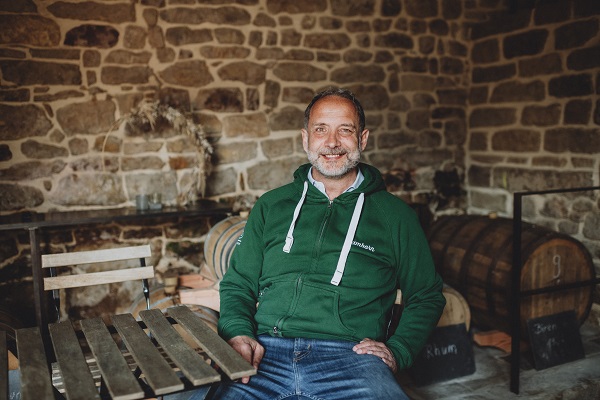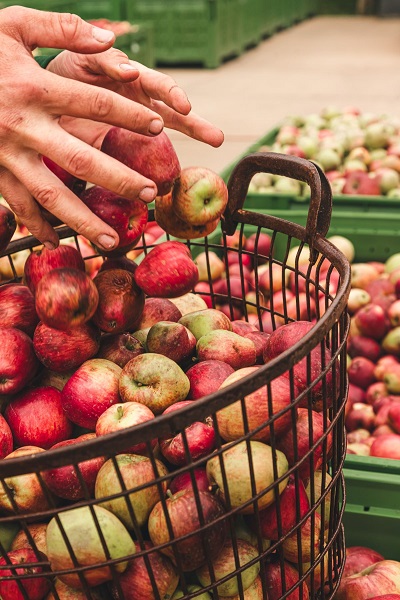 Carlo Hein, co-founder of Ramborn Cider Co.;
Credit: Ramborn / Véronique Kolber
Carlo Hein, co-founder of Ramborn Cider Co.;
Credit: Ramborn / Véronique Kolber
Chronicle.lu recently reached out to Carlo Hein, co-founder of Ramborn Cider Co. (Luxembourg's first cider producer), to learn about this year's apple and pear harvest.
Chronicle.lu: What were the approximate dates of this year's apple and pear harvest season and did the timing and/or duration differ from previous years?
Carlo Hein: The season start was, as always, end of September. However, this year the season was very short due to the small amount of fruit to harvest.
Chronicle.lu: Now that the season has ended, what were your main observations, i.e. in terms of the quantity and quality of the harvest?
Carlo Hein: Old traditional orchards produce large quantities of fruit every second year. We have observed that the 2023 harvest was quite poor, so we anticipate that the 2024 harvest will be a bumper year! Ancient varieties of fruit used for cider making are always highly prized for their unique qualities and contributions to traditional cider production. These varieties, sometimes referred to as "heirloom" or "heritage" fruits, offer a range of distinct characteristics like flavour complexity, tannins, aromatics and balance.
Chronicle.lu: Please elaborate on the types of apples and pears Ramborn uses for its cider.
Carlo Hein: As previously mentioned, we exclusively use local heritage fruits to produce our beverages. Old fruit varieties often possess a more complex and nuanced flavour profile compared to modern, intensive fruit cultures. They can offer a diverse range of taste notes, including fruity, floral, tart and tannic elements. This complexity results in more interesting and rich-tasting ciders than their mainstream alternatives.
Chronicle.lu: Approximately how many apples and pears have been picked this season and how much cider can be produced from these?
Carlo Hein: We must align our work and production planning with the rhythm of nature. During bumper years, we process hundreds of tonnes of fruit. Depending on the fruit, 50% to 75% of the weight of the fruit is transformed into juice. The cider-to-be is securely stored in stainless steel barrels at a consistent temperature, allowing it to age gracefully while retaining its exceptional qualities for a fairly long period of time, until it's bottled and sold throughout the country and beyond its borders.
Chronicle.lu: To what extent do you feel the dry and hot weather followed by intense rainfall has had an impact on this year's harvest?
Carlo Hein: The previous summer's conditions have undeniably had an adverse effect on the ageing orchards, which were already under stress due to their advanced age and the presence of mistletoe. Therefore, the restoration work in the orchards and the planting of young trees represent a top priority in Ramborn's mission and activity all year round.
Chronicle.lu: Please tell us about the Harvest Weekend you organised on Saturday 30 September and Sunday 1 October 2023 (number of participants, etc.).
Carlo Hein: More than 1,000 visitors attended the Harvest Days weekend - an exceptional turnout - and three tonnes of apples were picked. Exploring the orchards and hand-picking apples using sticks with baskets, just as it was done a century ago, is a cherished tradition in Luxembourg's harvesting culture. We partnered with like-minded organisations from our local community to build the event's programme, which also included free freshly pressed juice and cider tastings, a cider and food pairing masterclass, delectable street food, kids' arts and crafts activities, and live music.
Chronicle.lu: Do you also rely on seasonal workers during the harvest season?
Carlo Hein: Since the beginning, we have relied on local seasonal workers, residing in the village. As our efforts to collect forgotten fruit from a wider area expand, we are investigating fresh approaches to gather the overlooked fruit resource. Ideas for the future include community harvesting initiatives and international youth programmes. Although harvesting is physically demanding, the close connection with nature, the landscape and the people create precious moments to be cherished and shared.

(Photo credit: Ramborn / Daria Prykolota)









